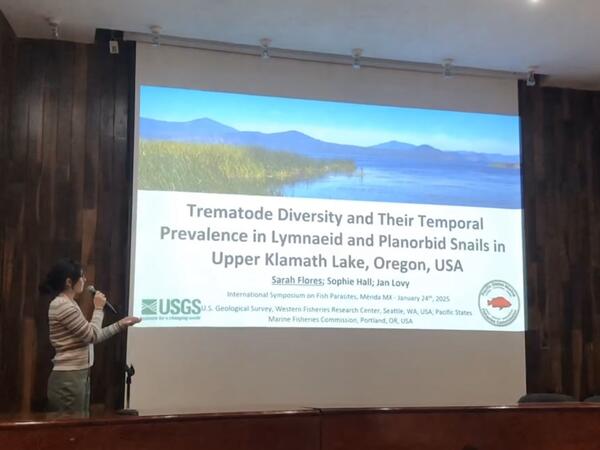Partner Experience: Keeping an Eye on Flukes in Upper Klamath Lake
Biologist Sarah Flores of the Pacific States Marine Fisheries Commission shares how her collaborative science with the Western Fisheries Research Center could help us understand what’s impacting juvenile sucker survival in the Klamath Basin.
While the recent removal of the Klamath Dams may promise more habitat for salmonids, endangered Shortnose and Lost River suckers upstream face continuing threats. In Upper Klamath Lake, low survival of juvenile suckers has resulted in fewer fish reaching reproductive age, creating a population structure skewed toward elderly fish and placing suckers at risk for extinction.
The exact cause of mortality in juvenile suckers in Upper Klamath Lake remains unknown, but scientists at the USGS Western Fisheries Research Center (WFRC) are working to understand potential factors. Dr. Jan Lovy and his lab hypothesize that disease may play a role in limiting their survival. Among the possible culprits are flukes, trematode parasites with a complex three-host life cycle.
WFRC relies on strong partnerships to execute our science. In this case, Lovy is working closely with Pacific States Marine Fisheries Commission biologist, Sarah Flores, to understand whether eye and musculature flukes may be impacting the survival of suckers in the lake.
“It is important for us to investigate the community structure of fish pathogenic trematodes such as eye flukes and how it changes seasonally. This information will help us better understand whether these parasites potentially limit juvenile sucker survival at specific timepoints throughout the year,” Flores says.
Flores got her start in disease science in an unusual place: working with parasites in monkey poop as an undergraduate researcher. After falling in love with parasitology, Flores found a graduate program that used genetic methods to study Contracaecum, a heartworm that can kill some fish species. Work with this parasite eventually brought her to WFRC, where she continues to study Contracaecum as well as eye and musculature flukes.
To understand the role of flukes in sucker mortality, Sarah is focused on looking one step before infection happens – at the intermediate host: snails. Snails are capable of shedding tens of thousands of infective parasites into the water every day. When the parasites encounter fish, the trematodes burrow through skin, often blinding the fish and impacting their movement. Infected fish make easy prey for birds, who then ingest the flukes as they consume the fish. The flukes then produce eggs, which travel through the birds' feces back into the water where they can infect snails, completing the cycle.
In the Upper Klamath Lake, warming temperatures, habitat alteration, and inputs of nutrients have led to an altered ecosystem which may be leading to a greater abundance of snails. More snails may potentially increase the number of fluke parasites. Seeking to understand if these environmental conditions could help explain increased juvenile sucker mortality, Flores and her colleagues traveled to Upper Klamath Lake in summer of 2024 to quantify presence of trematode parasites in snails. After collecting the snails, Flores and Lovy screened them for trematode presence and used complementary genetic information to identify parasite species. The results are forthcoming.
This January, Flores and Lovy presented the status of their work on the temporal dynamics of eye flukes and their relative virulence at the International Symposium for Fish Parasites in Mérida, Mexico.
The next step in this work is to gather seasonal information.
“We are looking forward to sampling earlier in the 2025 season and collecting additional snail species which will help us provide further resolution on the timeline of potential fish exposure,” says Flores.
Flores’ work is just one example of how we partner with the Pacific States Marine Fisheries Commission on joint science priorities.
The work described above is funded by our partners at the Bureau of Reclamation, which also provided field and laboratory support and logistics in Klamath Falls.
Get Our News
These items are in the RSS feed format (Really Simple Syndication) based on categories such as topics, locations, and more. You can install and RSS reader browser extension, software, or use a third-party service to receive immediate news updates depending on the feed that you have added. If you click the feed links below, they may look strange because they are simply XML code. An RSS reader can easily read this code and push out a notification to you when something new is posted to our site.





